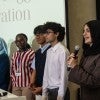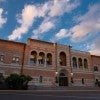
For more than 30 years, the School Literacy and Culture program at Rice’s Glasscock School of Continuing Studies has been steadily transforming classrooms and imaginations across the Houston area.

For more than 30 years, the School Literacy and Culture program at Rice’s Glasscock School of Continuing Studies has been steadily transforming classrooms and imaginations across the Houston area.

Superconductivity’s halo: Rice theoretical physicist helps map rare high-field phase
Rice's Andriy Nevidomskyy is part of a team that has mapped and explained a puzzling form of superconductivity that arises only under strong magnetic fields.

Rice deputy registrar advocates on Capitol Hill for expanded higher education access
Schilke was one of 31 advocates to represent the American Association of Collegiate Registrars and Admissions Officers on Hill Day.

A new report from Rice’s Baker Institute for Public Policy compares the cost of receiving care at Baylor St. Luke’s Medical Center, Houston Methodist Hospital and Memorial Hermann-Texas Medical Center using insurers’ price transparency files. The data suggests that employers can use the new information to achieve significant savings by choosing insurers that have negotiated lower prices with the major hospitals and by encouraging workers to choose lower priced hospitals within their insurance plan.

Rice men’s basketball team heads to Europe with culture, curiosity in tow
In preparation for its August trip through Belgium and France, the team participated in two cultural workshops designed and led by School of Humanities faculty members.

In low-resource settings, babies born with gastroschisis — a congenital condition in which the developing intestines extend outside the body through a hole in the abdominal wall — face life-threatening challenges.

Interns innovate for impact at Rice’s Summer Experience in Engineering Design showcase
In an impressive display of creativity, collaboration and global impact, undergraduate students from around the world gathered at Rice July 24 to present the results of their seven-week Summer Experience in Engineering Design internship.

Tapia STEM Camps inspire more than 1,200 students worldwide to pursue science careers
Founded by Richard Tapia, the summer camps encourage students from all communities to pursue careers in STEM.

Rice has 332 athletes named American Conference All-Academic team
Rice saw 332 student-athletes be named to the American Conference All-Academic Team, conference commissioner Tim Pernetti announced Wednesday morning.

Kavraki elected to European Academy of Sciences
Lydia Kavraki has been elected to the European Academy of Sciences.

‘Major leap in bioelectronic sensing’: Rice researchers turn bacteria into tiny pollution detectors
A study led by Xu Zhang, Marimikel Charrier and Caroline Ajo-Franklin demonstrates an innovative method for the real-time, on-site detection of arsenite and cadmium.

Bats, poaching and the pulse of the forest: Rice researchers lead biodiversity study in Tanzania
Deep in the heart of Tanzania’s Udzungwa Mountains, a trio of Rice researchers embarked on an ambitious summer field study to understand how human impacts are reshaping forest ecosystems.

Rice football single-game tickets now on sale
Single-game tickets for the inaugural season of the Scott Abell era of Rice football are now on sale.

Breaking the cycle: Housing instability shapes lives while hitting some harder than others
New research, led by Brielle Bryan, offers a clearer view of what instability really looks like and why it should be treated as a driver of inequality, not just a symptom.

Rice Business MBA programs earn top recognition in Princeton Review rankings
Rice Business MBA programs are ranked among the top five in The Princeton Review’s Best Business Schools rankings for 2025. The school is No. 3 in the nation for Best MBA Program for Finance, up two spots from last year, and No. 5 for Best Online MBA.